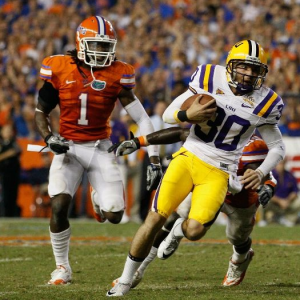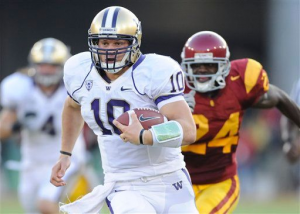
Janoris Jenkins (#1) can't stop a fake field goal
One of the prospects who has impressed me the most this year is Florida cornerback Janoris Jenkins. I’ve had him in the top ten of my mock drafts, just behind Patrick Peterson (CB, LSU) and Prince Amukamara (CB, Nebraska). It might be time to temper those expectations for him, at least for the time being. Jenkins shut down Julio Jones (WR, Alabama) last week but he struggled against LSU’s Terrance Toliver in the open-field. It’s not a stock killer because Toliver is capable of much more than he’s shown so far. His six catch, 111 yard and 2 TD performance against the Gators was long overdue – he only had 148 yards and zero touchdowns in LSU’s previous five games.
There were two almost identical plays that stood out. Overall Jenkins was decent in coverage, showed good reaction skills as the play developed and was willing to turn and get involved when the ball wasn’t thrown his way. Indeed, he wasn’t targeted that often by LSU’s duel threat at QB and it’s a sign of the growing respect Jenkins has earned. He got called on a corner blitz and showed great closing speed to pressure a bad throw and deliver a good, solid QB hit. Jenkins also showed some ability as a kick returner, but a good run was called back for an illegal block and an unnecessary spiking of the ball on the sidelines.
The first big play against Jenkins came with 1:31 left in the first half. Toliver ran a slant and did well to pull in a difficult grab off balance. As two defenders closed, Toliver pulled off a superb spin move to avoid both and get into the open field. Jenkins initially does really well to anticipate the move and close quickly on Toliver to make the tackle. However, he doesn’t do a good enough job at all of wrapping up and Toliver simply drags him 10-12 yards into the end zone. He needs to make that tackle and whilst Toliver is 6-5 and 203lbs, it’s not like he was trying to bring down Mark Ingram.
An almost identical incident occurred with 23 seconds left and the game on the line. This time Jenkins is covering Toliver and takes a bad angle as a simple short slant is caught with far too much ease. Jenkins reacts and again initiates the tackle, but cannot bring the receiver down. Toliver makes another 12 yards, dragging Jenkins along as he desperately tries to complete the play. It set up LSU for a game-winning touchdown pass and the victory, when a good solid open-field tackle may have restricted them to a field goal and over time.
Jenkins’ coverage skills and big play ability will mean more to scouts and GM’s than his open-field tackling, but it’s something he needs to work on. He has good coverage skills, good reactions. He can be a kick return threat at the next level. However, he really needs to work on wrapping up in future and it certainly helped LSU put 14 points on the board.
Patrick Peterson was the other big cornerback feature in the game – but it was almost impossible to judge him on this performance. He was off the field injured and in some pain for large portions of the game. When he was in action, Florida never tested him. He made a couple of good plays in run support – as you’d expect for a corner his size. He did have a badly botched punt for a turnover though – uncharacteristic because his special teams play has been excellent so far.
**QB Watch**
–Christian Ponder (QB, Florida State) proved he can win big games on the road with a comprehensive 45-17 win over Miami. The performance summed up Ponder for me – he managed things well without being physically dominant. He completed just 12/21 passing for 173 yards, two scores and an interception. Ponder gets a mid-round grade at this point and certainly doesn’t deserve to be talked amongst the early first round prospects.
–Ryan Mallett (QB, Arkansas) was also victorious in his first game since defeat to Alabama. He put up the big numbers and continues his major improvement in completion percentage this year – getting 310 yards from 27/38 with three TD’s and a pick. However, a good 24-17 win over Texas A&M was spoilt somewhat by Mallett’s petulance – striking a defender, arguing with anyone who’d listen and ignoring the coaches. It’s that kind of attitude that will hold back Mallett’s stock.
–Andrew Luck (QB, Stanford) matched up Jake Locker by helping his team defeat USC with a late field goal. Luck completed a lot of high percentage throws for 20/24 and 285 yards (3 TD’s). If he keeps winning, the hype will continue and it’ll keep his stock high. I still don’t think Luck is either physically outstanding or accurate enough to warrant the #1 overall pick, but whilst ever he’s being described ‘the best QB in college football’… he’ll be at the forefront of most people’s minds – including GM’s.
–Jake Locker (QB, Washington) and the Huskies lost at home to Arizona State. Locker failed to convert a couple of fourth down plays – something that has been a problem this year for Washington. The numbers weren’t really good or bad – 23/38 for 209 yards and a touchdown. Locker had a late pick in the end-zone on a hit and hope. It’s important to remember that Locker was reportedly very ill ahead of this game. However, a lot of people voice concerns about Locker’s ability to get it done against lesser teams. This is one that got away.
**Other notes**
–A.J. Green (WR, Georgia) had 96 yards and a touchdown from six grabs as Georgia defeated Tennessee. In two games since his suspension, Green has 215 yards and 3 TD’s playing on a bad offense. He will be a top ten pick next year and could go as early as first overall depending on which team owns the pick. They won’t – but if St. Louis had that #1 choice again this year – it’d be a no brainer to pair Green with Sam Bradford.
–Ryan Kerrigan (DE, Purdue) got his sixth sack in five games in a 20-17 win over Northwestern. I’ve had him in the top-20 of my mock because he’s rising quickly. Teams will be interested in his effort and production. I understand why others don’t want to move him even into round one but good publicity, improved technique and big production will turn what would’ve been a third round pick last year into a potential top choice in 2011.
–Julio Jones (WR, Alabama) and Marcell Dareus (DT, Alabama) both stepped up even in a losing effort. Jones responded after a quiet game against Florida with 118 yards, eight catches and a touchdown. Dareus provided constant inside pressure and got his first sack of the year against South Carolina. Jones’ stock is hard to second guess right now – I could see top-20, I could see second round. Dareus should be a top-20 pick. Mark Ingram (RB, Alabama) had a frustrating afternoon as ‘Bama went away from the pass, he got just 11 carries and 41 yards.

 North Carolina came into 2010 with a star studded defense full of top draft prospects. Today, three of those prospects were officially ruled out for the year. UNC made star defensive end Robert Quinn and receiver Greg Little ineligible and dismissed defensive tackle Marvin Austin. The NCAA said Quinn and Little were to be made ineligble after violating rules involving agent benefits, preferential treatment and ethical conduct. Reports
North Carolina came into 2010 with a star studded defense full of top draft prospects. Today, three of those prospects were officially ruled out for the year. UNC made star defensive end Robert Quinn and receiver Greg Little ineligible and dismissed defensive tackle Marvin Austin. The NCAA said Quinn and Little were to be made ineligble after violating rules involving agent benefits, preferential treatment and ethical conduct. Reports 





